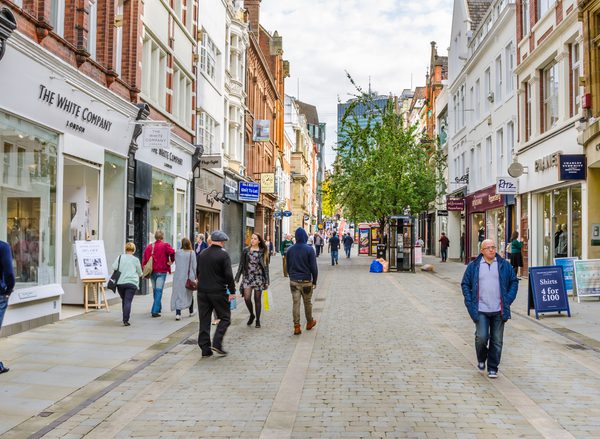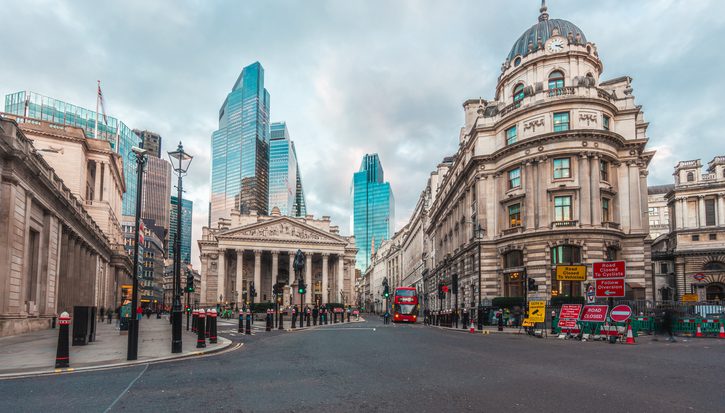
Business rates are stuck in the past: The enduring case for an online sales tax
Article
About our future-facing tax blog series from guest author Mark Lloyd
A budget and spending review loom in the autumn, posing some choices for the new government.
It is right that the government’s clear stated preference is to improve the public finances by growing the economy, but the new chancellor will surely also need to consider options to improve the fairness and sustainability of the UK tax base, and to find the resources needed to begin the repair job now. The UK’s tax system is overdue for improvement, is not fit for the future economy, and successive administrations have dodged the hard choices on tax reform.
In this series of IPPR blogs, Mark Lloyd puts forward some realistic, implementable reforms for this parliament to set the tax system up well for the future, to meet the government’s wider policy objectives, and to raise revenues.
Mark Lloyd is an economic policy specialist who has advised ministers on tax policy and industrial strategy in HM Treasury and 10 Downing Street. He is currently working in the international development sector, where he supports both national and local governments in developing countries on a wide range of policy and delivery issues. He is writing these discussion papers for IPPR as a guest author.
Britain’s business tax system is out of date. Taxation falls more onto traditional ‘bricks and mortar’ businesses with physical premises, while online retail and services are more lightly taxed.
This isn’t unique to the UK – but Britain’s problem is particularly acute, and this boils down to one major legacy tax: business rates. As the budget looms, business leaders have renewed their calls for business rates reform.
If there’s one thing everyone knows about business rates, it’s that they weigh on high street businesses, and can be tough on places like pubs and entertainment venues. The new government has promised to replace business rates with a system that raises the same overall revenues by 'levelling the playing field between the high street and online giants', but details have been scarce.
Rate or slate?
So what are business rates? Simply, they are an annual tax on the value of business property – similar to council tax for homes. They’re levied by local authorities, who get to keep some of the revenues. Business Rates raise around £26 billion per year.
International comparisons suggest that UK raises more revenue from property taxes than many of our peers, with high rates on commercial property. This high tax burden makes it harder for high street businesses to compete with online sellers, and arguably compounds the wider decline in the high street.
The upshot is that ministers consistently find themselves under pressure to relieve different types of businesses in some way – whether it’s discounts for smaller businesses, pubs and petrol stations, or even whole sectors like retail and hospitality. The cost of all these business rate reliefs now stands at around £8 billion a year – around a quarter of the theoretical tax base.
These issues lay behind the previous government’s 'fundamental review of business rates' back in 2020–22, and a consultation on whether to introduce a new 'online sales tax' (OST), to help rebalance taxation away from the high street, and towards the digital sector.
Unfortunately, although the 'fundamental review' led to some positive changes it did not address many of the biggest issues in the business rates system, and the consultation on an OST concluded that a new levy was just a bit too difficult, pouring cold water on the idea. This was short-sighted. The problem that policymakers must face up to on business rates reform, is that the existing system of taxation on property is simply not set up to ‘save the high street’. There has been a fundamental shift in consumer demand that needs to be reckoned with.
Some have suggested that a tax cut for high street businesses could be met by increasing taxes on the things like large warehouses and data centres, or on business property in other sectors like IT, finance and business services (eg offices). Unfortunately, these tax bases are just not big or stable enough, and doing so could have major unintended consequences that outweigh the benefits (it’s not just the tech giants that use offices, warehouses and data centres).
It’s the (online) economy, stupid
Let’s ask the obvious question; if high street sales are shrinking, where are they going? The answer is the sales are happening online instead of in person.
A so-called 'online sales tax', then, targets exactly the right kinds of activity. Such a tax, if implemented correctly, could form a new and sustainable ongoing revenue base which would almost certainly grow over time.
A tax of this kind could be used to fund business rate reductions for key sectors in the economy in a way that rebalances directly towards ‘real’ (high street) activity and away from ‘remote’ (online) activity. Any new tax naturally requires difficult choices and trade-offs, but these are not insurmountable.
An OST is not so difficult to design
Many of the reasons put forth in the previous government’s response to the OST consultation as to why such a proposal would not work are, on closer inspection, surmountable. Every (new) tax requires making some big choices on the overall design, and then a bunch of smaller, techy choices about boundaries and edge cases – and in this regard the challenges for the OST are not remarkable.
An ‘online’ tax or a ‘remote’ tax?
A lot of the government response focused on how hard it is to define an 'online' sale (even though the OECD and the ONS manage it just fine). This is because customers and businesses might use a mix of online and offline channels (databases, catalogues, phone calls etc) in the process of completing a sale or service.
This seems to complicate how an 'online' sales tax would operate. But fear not, the answer is that, much as with our gambling taxes, it can be resolved by defining the tax as a 'remote' sales tax instead, to capture all distance sales and avoid 'channel shifting' between different forms of remote sale. This makes sense; the tax is there to encourage people to shop on the high street, so the tax should apply to phone sales, which also don’t require anyone to visit the high street.
This approach also solves a big avoidance risk. An example of this might be if you chose a sofa online, but when you come to pay you are then directed to an automated telephone line to complete the sale, simply to avoid it being classed as ‘online’. A ‘remote sales tax’ (RST) resolves this.
Consumption tax, or tax on businesses?
The other question is whether the RST should be a tax just on consumers, or on business-to-business sales. It’s clear it should be a consumer tax. Remember, it is consumers, that we want to visit the high street, rather than shop online. Distinguishing between consumers and business customers is a well-established process where a business supplies their VAT number to show that they should not pay VAT. This should apply for the RST too – including the ability to reclaim RST if it was paid by mistake.
After these fundamental choices, the rest is straightforward. For the purposes of sketching out such a tax, let’s assume the following.
- An RST would apply to all remote (online, phone) purchases of goods (with home delivery) and services, at a rate of, say, 1 per cent of the total cost.
- ‘Click and collect’ goods (either from store or from collection lockers) could get a discounted rate in recognition that this 1) reduces congestion/pollution from home deliveries and 2) results in theoretical footfall to retail premises.
- Businesses selling remotely below a revenue threshold (say £10 million) would be exempt, much like in other taxes. However, if firms are selling via a big platform/marketplace (eg eBay, booking.com, Etsy) then it makes perfect sense for the platform to add the charge, and for the liability to pay the tax to sit with the platform too.
- Anyone who chooses to buy something through an in-store channel while physically located in a store (whether that’s a salesperson, tablet or interactive till) is making an in-store purchase; it doesn’t matter whether an app and an internet connection is used in the process, or whether it’s a bulky item like a sofa that will be delivered later (this where the concept of 'remote' is more helpful than 'online').
- A similar thing would apply to services – eg visiting a travel agent – who then helps to search for your desired package using the internet. This is not a remote sale, it is still an in-store, in-person sale, and the customer has used a high street business.
Takeaway food is perhaps the hottest potato to handle, as a lot of this is ordered remotely. The £10 million revenues threshold would exempt most independent takeaways. But today many restaurants rely on the likes of Deliveroo and UberEats to manage their takeaway business.
These are big platforms and should be treated the same as eBay or Amazon for goods, with the charge added by the platform. If that’s too hard to stomach, takeaway food could be excluded entirely from the tax, but this would be difficult to justify.
In summary, there’s nothing fundamental that undermines an RST. Of course, any chancellor looking at this would need to think about the effect on some specific sectors with their own dynamics. For example, it may make sense to carve out insurance and financial services remote sales. The read across to high street retail here is not as strong, so it would be defensible.
A sustainable and growing revenue base
Although HMT’s revenue estimates for a tax of 1–2 per cent were low (around £1 billion) there will be options to design the tax to start small, or go larger, and in any event revenues are likely to grow over time. An RST could even be designed to have tiered rates for different volumes of online sales - ie taxing Amazon more than you’d tax a smaller platform that was just getting started, in recognition of the market power that comes with network effects.
Rough calculations of the overall market size of online retail are in the region of £115 billion per annum. It is not inconceivable to extract, say, 3 per cent from this through exercising some of those design choices. At around £3 billion per annum, this would handily, almost entirely fund the 'temporary' reliefs to small businesses and retail and hospitality in the business rates system.
Given that any revenues from the OST were being funnelled directly back in business rate cuts, then many of ‘bricks and clicks’ operators who operate both online and bricks and mortar channels would see the benefits of the redistribution. Indeed, it was some of these very same businesses who were proponents of the tax initially.
Finally, then, would this be popular? Are taxes that hit consumers ever popular?
Well, sometimes. The so-called sugar tax worked in part by raising the prices of sugary drinks to nudge consumers towards healthier options. The revenues were spent on school sports and breakfast clubs. People liked it.
People care intensely about the decline of their local high streets. But just like the sugary food that can make us fat, the prospect of cheap online shopping keeps many people indoors while they bemoan the shuttered shops on their high street.
If government can show that this new Amazon tax would sustainably help local high streets, and maybe nudge a few people to visit them once in a while, then it has a fighting chance of being recognised as a good thing, in moderation.
You might also like ...

Rule of the market: How to lower UK borrowing costs
The UK is paying a premium on its borrowing costs that ‘economic fundamentals’, such as the sustainability of its public finances, cannot fully explain.
Rachael Henry discussing the Budget on GB News

Fairness first: How the budget can make life better and the economy stronger
The chancellor faces a daunting task at the upcoming budget. A fiscal gap sets the stage, putting the chancellor in the unenviable position of having to raise taxes.